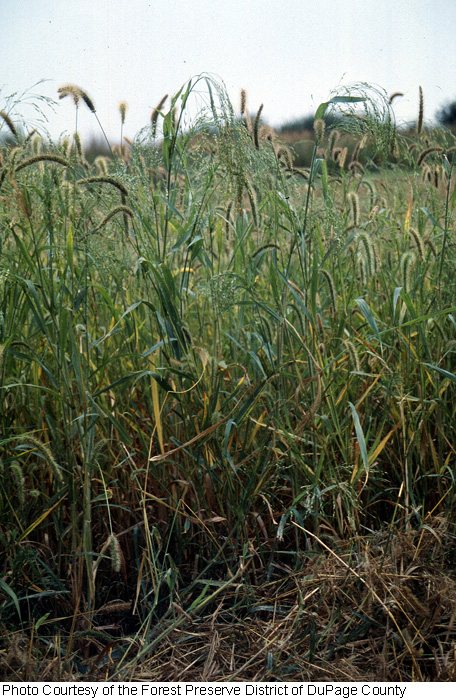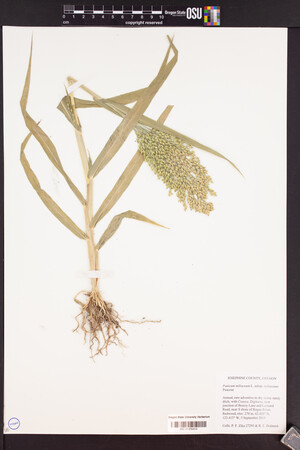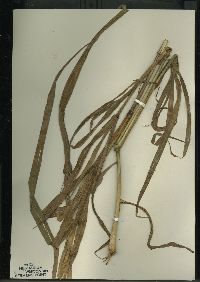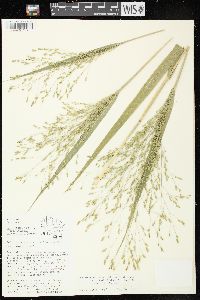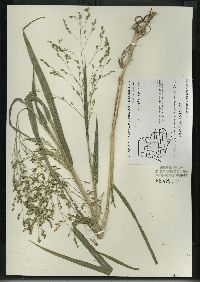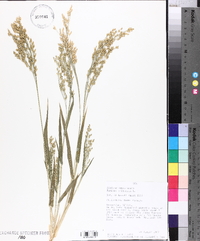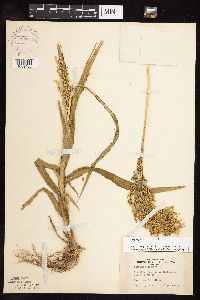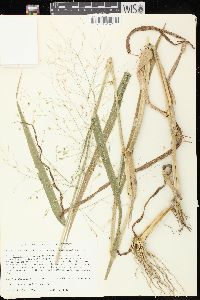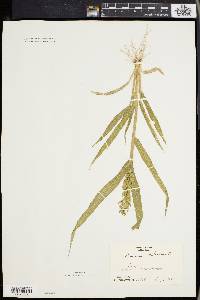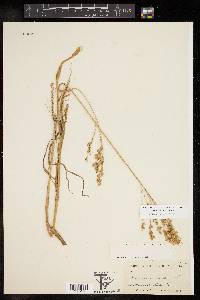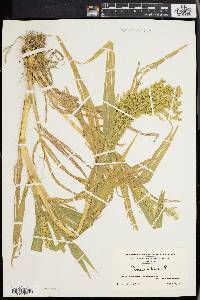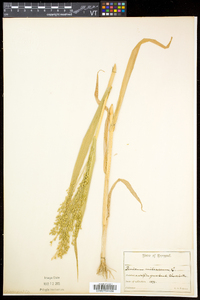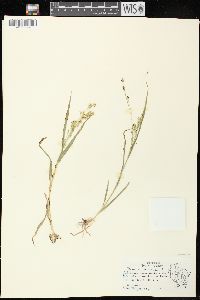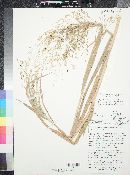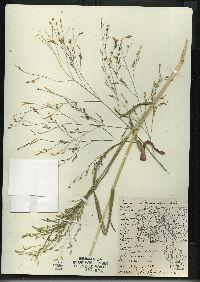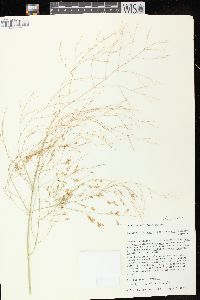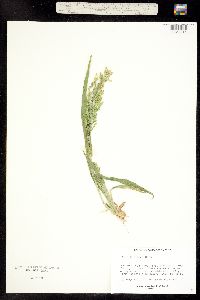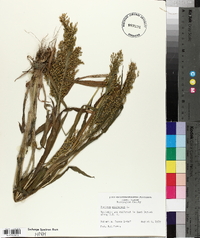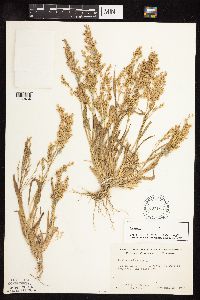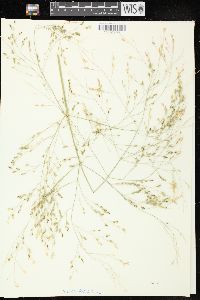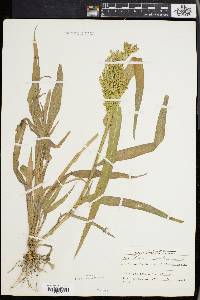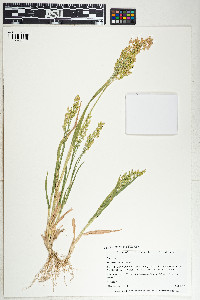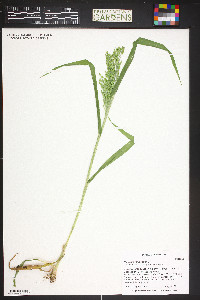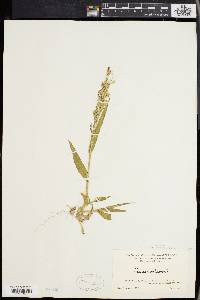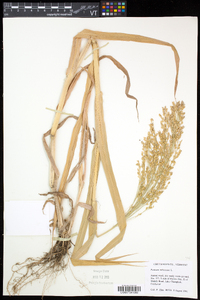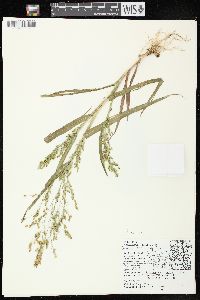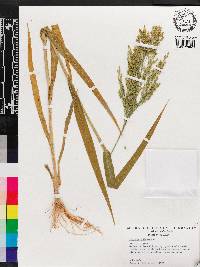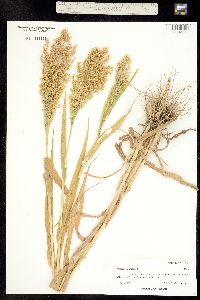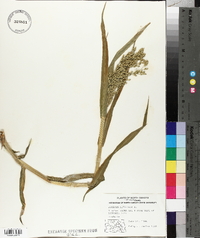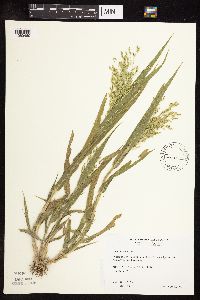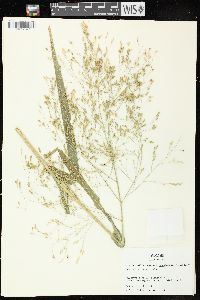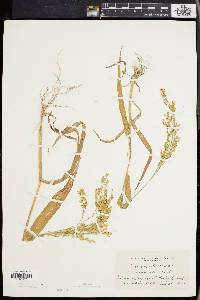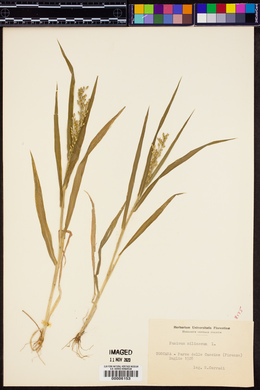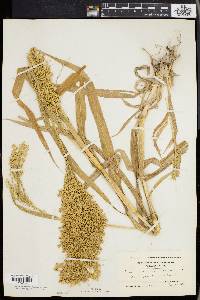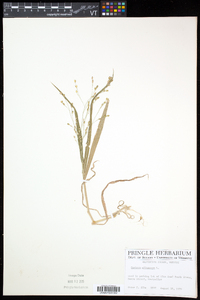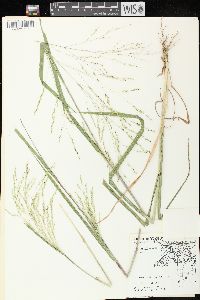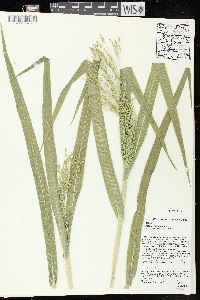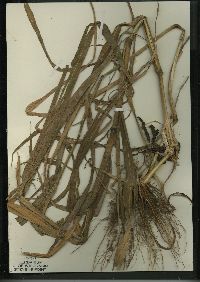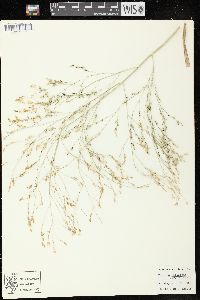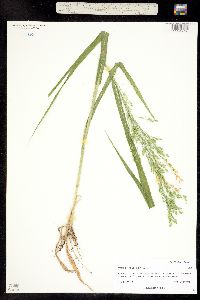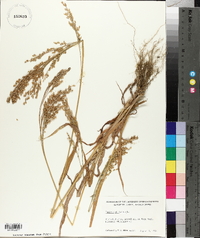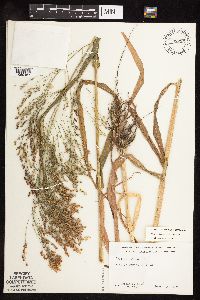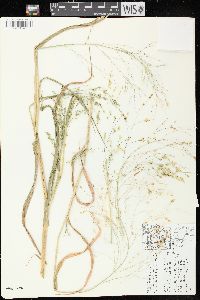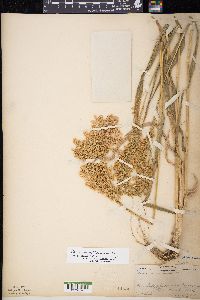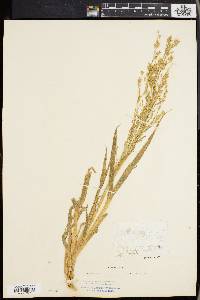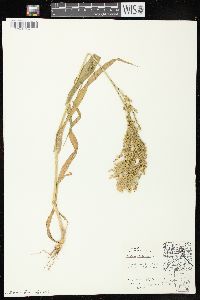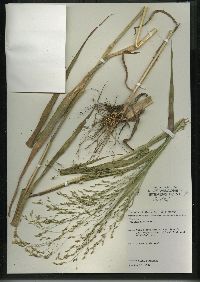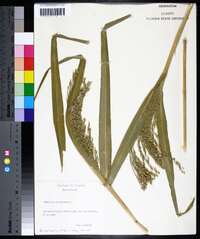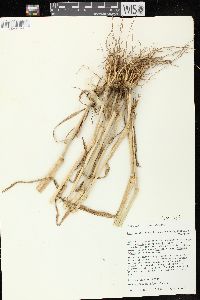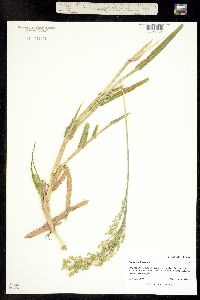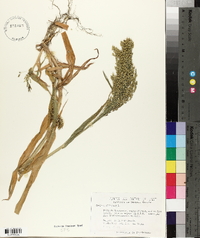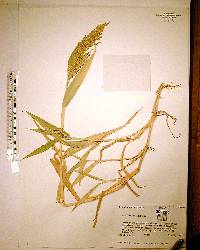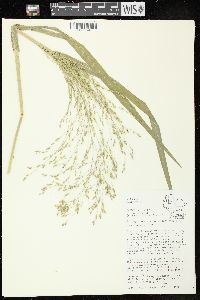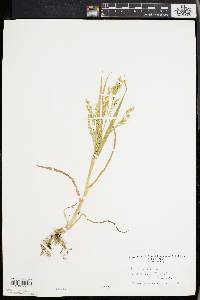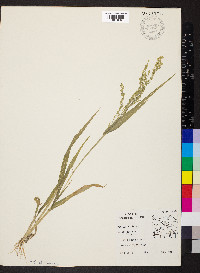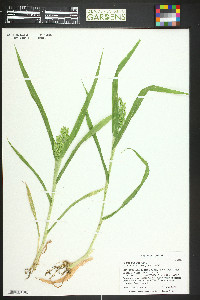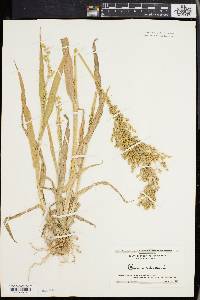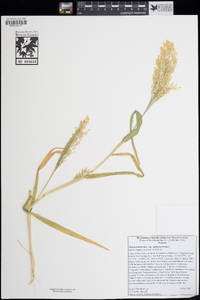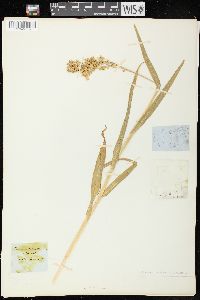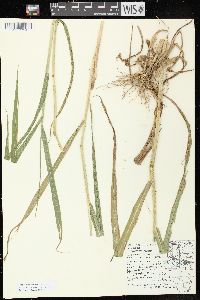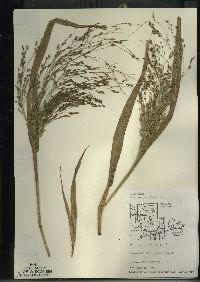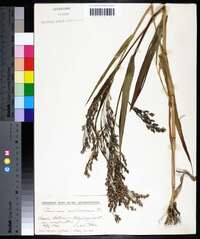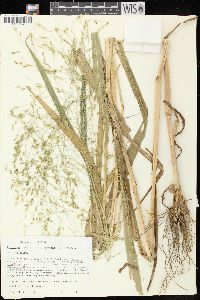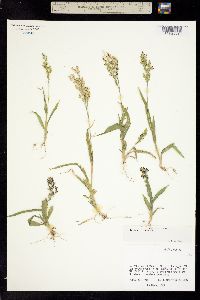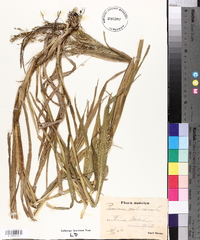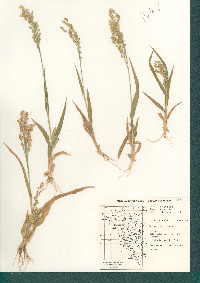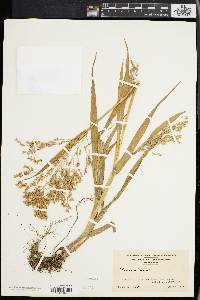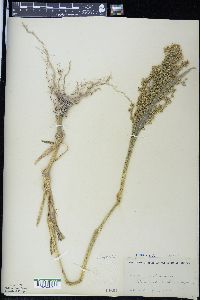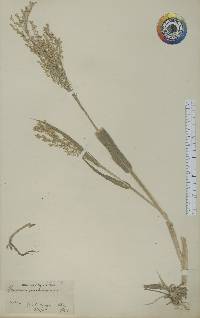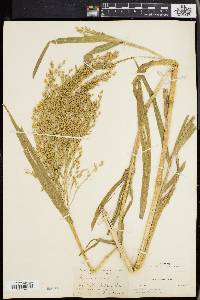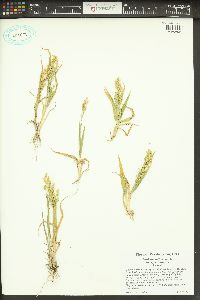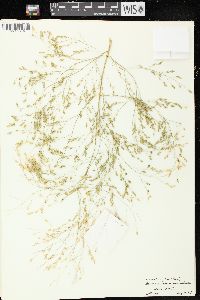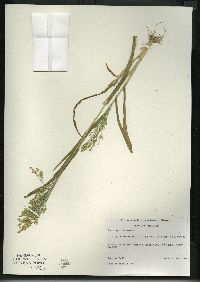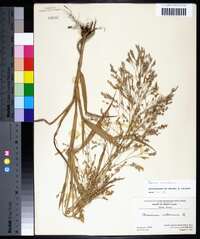Panicum miliaceum
|
|
|
|
Family: Poaceae
Hog Millet, more...blackseeded proso millet, broomcorn millet, broomcorn panic, panic millet, panicum, proso, proso millet, wild millet, wild proso millet, Broomcorn, Millet Commun
[Leptoloma miliacea (L.) Smyth, moreMilium esculentum Moench, Panicum asperrimum Fisch., Panicum miliaceum subsp. agricola H.Scholz & Mikolá, Panicum miliaceum var. miliaceum L.] |
Dr. David Bogler, USDA NRCS PLANTS Database Annuals, Terrestrial, not aquatic, Stems nodes swollen or brittle, Stems erect or ascending, Stems geniculate, decumbent, or lax, sometimes rooting at nodes, Stems caespitose, tufted, or clustered, Stems terete, round in cross section, or polygonal, Stem nodes bearded or hairy, Stem internodes ho llow, Stems with inflorescence less than 1 m tall, Stems, culms, or scapes exceeding basal leaves, Leaves mostly cauline, Leaves conspicuously 2-ranked, distichous, Leaves sheathing at base, Leaf sheath mostly open, or loose, Leaf sheath smooth, glabrous, Leaf sheath hairy at summit, throat, or collar, Leaf sheath and blade differentiated, Leaf blades linear, Leaf blades 2-10 mm wide, Leaf blades 1-2 cm wide, Leaf blades mostly flat, Leaf blades mostly glabrous, Leaf blades more or less hairy, Leaf blades scabrous, roughened, or wrinkled, Ligule present, Ligule an unfringed eciliate membrane, Inflorescence terminal, Inflorescence an open panicle, openly paniculate, branches spreading, Inflorescence a contracted panicle, narrowly paniculate, branches appressed or ascending, Inflorescence solitary, with 1 spike, fascicle, glomerule, head, or cluster per stem or culm, Inflorescence lax, widely spreading, branches drooping, pendulous, Inflorescence curved, twisted or nodding, Inflorescence branches more than 10 to numerous, Flowers bisexual, Spikelets pedicellate, Spikelets dorsally compressed or terete, Spikelet less than 3 mm wide, Spikelets with 1 fertile floret, Spikelets with 2 florets, Spikelet with 1 fertile floret and 1-2 sterile florets, Spikelets solitary at rachis nodes, Spikelets all alike and fertille, Spikelets bisexual, Spikelets disarticulating below the glumes, Rachilla or pedicel glabrous, Glumes present, empty bracts, Glumes 2 clearly present, Glumes distinctly unequal, Glumes equal to or longer than adjacent lemma, Glume equal to or longer than spikelet, Glumes 4-7 nerved, Glumes 8-15 nerved, Lemma similar in texture to glumes, Lemma 8-15 nerved, Lemma glabrous, Lemma apex truncate, rounded, or obtuse, Lemma awnless, Lemma margins inrolled, tightly covering palea and caryopsis, Lemma straight, Palea present, well developed, Palea about equal to lemma, Stamens 3, Styles 2-fid, deeply 2-branched, Stigmas 2, Fruit - caryopsis, Ca ryopsis ellipsoid, longitudinally grooved, hilum long-linear.
Annual herb, tufted 20 cm - 2 m tall Leaves: numerous, alternate, two-ranked. Sheaths round in cross-section, densely soft-hairy with deciduous, bumpy-based hairs. Ligules membranous, fringed with hairs (hairs 1 - 3 mm long). Blades 15 - 40 cm long, 0.5 - 2.5 cm wide, parallel-veined. Inflorescence: a branched arrangement of spikelets (panicle), 6 - 20 cm long, 4 - 11 cm wide, with stiff, appressed to spreading branches. Fruit: a caryopsis, indehiscent, enclosed within the persistent lemma and palea. Culm: stout, 20 cm - 2 m long, round in cross-section, internodes often with bumpy-based hairs. Nodes minutely hairy. Spikelets: solitary, found in the upper portion of the inflorescence, 4 - 6 mm long, egg-shaped. Glumes: unequal, herbaceous. Lower glumes 3 - 3.5 mm long, one-half to three fourths as long as spikelets, gradually tapering to a slender point, five- to seven-veined, veins minutely rough towards the apex. Upper glumes 4 - 5 mm long, slightly longer than upper florets, eleven- to fifteen-veined, veins minutely rough towards the apex. Lemmas:: Lower lemmas similar to upper glumes, 4 - 5 mm long, slightly longer than upper florets, nine- to thirteen-veined, veins minutely rough towards the apex. Upper lemmas shiny, with rolled-up margins on the upper surface. Paleas:: Lower paleas 1 - 1.5 mm long, up to half as long as the upper florets, transparent. Upper paleas longitudinally lined. Florets:: Lower florets sterile. Upper florets bisexual, straw-colored to orange or reddish brown or blackish, 3 - 4 mm long, 2 - 2.5 mm wide, pointed at the apex, more or less shiny. Anthers three. Stigmas red. Similar species: No information at this time. Flowering: late June to mid-October Habitat and ecology: Introduced from Asia and cultivated as a forage crop. It occasionally escapes into disturbed ground and is frequent around grain elevators. Occurence in the Chicago region: non-native Etymology: Panicum comes from the Latin word panis, meaning bread, or panus, meaning "ear of millet." Miliaceum means millet. Author: The Morton Arboretum FNA 2003, Gould 1980, Kearney and Peebles 1969 Common Name: proso millet Duration: Annual Nativity: Non-Native Lifeform: Graminoid General: Coarse annual, branching from lower nodes, stout stems 20-210 cm, hairy at lower nodes, sheaths commonly pilose or hirsute, internodes papillose based. Vegetative: Sheaths terete, densely pilose, with papillose based hairs, blades 15-40 cm long, 7-25 mm wide, pubescent or glabrous; ligule a short, ciliate, membranous collar, 1-3 mm. Inflorescence: Panicle with erect spreading branches 6-20 cm long, 4-11 cm wide, included or shortly exserted at maturity, dense; branches stiff, appressed to spreading, spikelets solitary, pedicels 1-9 mm, scabrous and sparsely pilose, spikelets 4-6 mm, ovoid, usually glabrous; lower glume one half to two thirds as long as the spikelets, 5-7 nerved, upper 11-13 veined, minutely roughened above, slightly exceeding upper florets, fertile lemma 9-13 veined; upper florets 3-4 mm long, 2-2.5 mm wide, smooth or striate, stramineous to orange, red-brown or blackish, disarticulating at maturity. Ecology: Found in disturbed areas, often near or closely associated with agriculture. Notes: Often found along the margins of old fields, fast germinating and short growing in late spring, with lower water requirements than any other cereal grains. Is generally a big component in bird seeds. Ethnobotany: Cultivated in Asia for thousands of years. Etymology: Panicum is a classical Latin name for millet, while milaceum means millet like. Synonyms: None Editor: SBuckley, 2010 Stout annual 2-6(-10) dm; sheaths overlapping, densely hirsute; blades elongate, rounded at base, 10-20 mm wide; panicle included at base, pyramidal to cylindric, dense, 8-20 cm, often nodding at maturity; spikelets turgid, acute, 4.5-6 mm; first glume half as long, acute or acuminate, 5-veined; second glume and sterile lemma equal, distinctly 7- or 9- veined; fr stramineous to brown, 3-3.5 mm; 2n=36, 54, 72. Native of the Old World, occasionally cult. for forage and adventive along roadsides and in waste places. A wild-adapted type, widespread as a field-weed in the midwest (Wis., Minn., Ill., Io., N.D., S.D., Nebr., Kans., Colo.), has been named ssp. ruderale (Kit.) Tzvelev. It is larger, 7-20 dm, with open panicles 10-50 cm, and deciduous spikelets. Gleason, Henry A. & Cronquist, Arthur J. 1991. Manual of vascular plants of northeastern United States and adjacent Canada. lxxv + 910 pp. ©The New York Botanical Garden. All rights reserved. Used by permission. From Flora of Indiana (1940) by Charles C. Deam ...... Deam (1929): Introduced from the Old World and sparingly escaped from cultivation in the cooler parts of the U.S. The seeds are readily eaten by all kinds of livestock and also relished by poultry. It is said to be grown sometimes for hog feed but I have not found a seedsman in Indiana who ever sold it for that purpose. Since it is used in a mixture of commercial birdseed, plants are likely to be found on garbage dumps where the seed might be carried from bird cages. |

